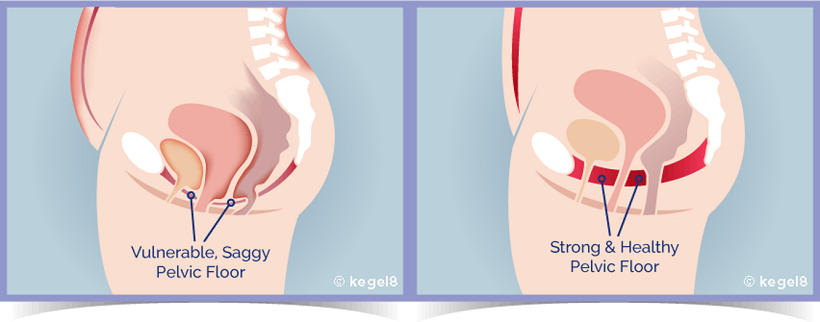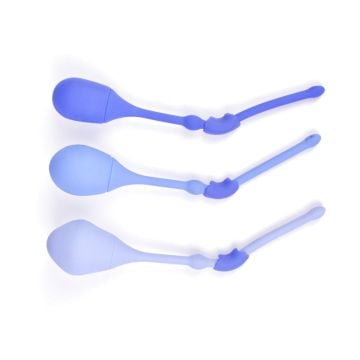
- Just like us, our pelvic floors change in form over time. Unfortunately, they will not stay their naturally fit and prime 20's selves. As we age, so do our pelvic floor muscles, that’s why it’s important to care for them and ensure they keep as strong as they can be to support us.
Read on to learn how your pelvic floor changes throughout your life…
20's Pelvic Floor
In your 20's (and before childbirth), your pelvic floor is at its prime. It’s uncommon that women in their 20's will suffer as a result of weak pelvic floor muscles – but, the opposite can cause a problem.
Pelvic floor muscles can be overly tight during this time, which can cause painful intercourse, or you may find it difficult to insert tampons.
30's Pelvic Floor
Despite pelvic floor strength peaking in your 20’s, more women choose to have children during their 30’s. But as fertility blossoms for some, others can be met with infertility – women in their 30’s can also begin to experience perimenopausal symptoms.
The biggest change in pelvic health during your 30’s is the strength of your pelvic floor muscles. In contrast to your tight and toned 20’s pelvic floor, your muscles may need a little extra work now. If you leave them to decrease in strength, you may experience a number of issues including incontinence and pelvic organ prolapse. And for those women choosing to have children, pregnancy and childbirth will only intensify these symptoms – so make sure your pelvic floor stays in tip top condition. Remember – your pelvic floor will also take a little longer to heal following childbirth when you’re in your 30’s.

But, it’s not all doom and gloom, you can safeguard the health of your pelvic floor by practicing Kegel exercises. These can help prevent damage during childbirth and lower your chance of developing a pelvic floor disorder after childbirth too.
“Doing pelvic floor exercises is a great way to start your awareness but doing them correctly is the key to safeguarding your PF health” says Clio Wood, Founder of family wellbeing company, &Breathe Postnatal. “I was never taught to release and when I first saw a women's health physio, it turned out that I was also lifting wrongly.”

40's and beyond
In your 40's, give a little extra care and attention to your pelvic floor. Pregnancy and childbirth will have put a major strain on your pelvic floor muscles, but an increase in body weight can make this even worse.
As the body loses oestrogen and menopause looms, you may notice that you put on weight much easier than when you were younger. In fact, fat mass can increase as much as 44% during menopause. So, it’s important to pay attention to diet and exercise during this time.
It’s extremely important to make sure that Kegels are a part of your daily fitness regime at this point of your life. Decreasing pelvic floor tone can cause urine leakage or a prolapse, so keep at your Kegels to maintain pelvic floor strength.
"Some of the older mums that we see [at &Breathe Postnatal retreats] are even more accepting of leakage and more, because they think it's normal for their age. I'm always surprised at the scant amount of consistent information women receive about their pelvic floors” says Clio, “Around half of all our guests [at &Breathe Postnatal retreats] are experiencing or have experienced pelvic floor issues, whether not strong enough or overly tight. What's frightening is what they think is 'normal' and have told themselves they have to live with it. Many women don't realise that they don't have to leak when they sneeze!”

Protecting Your Pelvic Floor
Improving and maintaining your pelvic floor strength is essential no matter your age. But it can be difficult to know whether you are doing your Kegels correctly. That’s where Kegel8 can help…
- The Kegel8 Ultra 20 Electronic Pelvic Toner uses neuromuscular stimulation (NMES or eStim) to work and strengthen your pelvic floor muscles for you – all with the push of a button. Plus, you can choose one of 20 physiotherapist-devised programmes to target intimate sensation, bladder weakness, and more!
- The Kegel8 Ultra 20 v2 rehabilitation for new mums is a must for all mums. You can use electrical stimulation to prepare your pelvic floor for pregnancy and use it after birth to repair and re-tone your muscles.
- The Kegel8 Kegel Weights Exercise Set is clinically proven and available for those looking for an extra challenge following the Pelvic Floor Wand. This set of 3 different sized kegel weights gives you a 12 week strengthening challenge for your pelvic floor – try it today!
Sources
[1] Kozakowski, J. et al. (2017) Obesity in Menopause – Our Negligence or an Unfortunate Inevitability? Menopause Review. 16(2): 61-65.
[2] Bellieni C. (2016). The best age for pregnancy and undue pressures. J Family Reprod Health. 10(3): 104-107. Available from https://www.ncbi.nlm.nih.gov/pmc/articles/PMC5241353/
[3] Mayo Clinic Staff. (2016). Perimenopause [online]. Mayo Clinic [viewed 06/03/2019]. Available from https://www.mayoclinic.org/diseases-conditions/perimenopause/symptoms-causes/syc-20354666
[4] Mayo Clinic Staff. (2017). Pelvic organ prolapse [online]. Mayo Clinic [viewed 06/03/2019]. Available from https://www.mayoclinic.org/diseases-conditions/pelvic-organ-prolapse/care-at-mayo-clinic/mac-20360560






